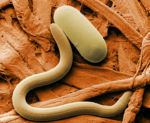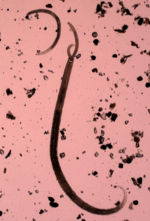Difference between revisions of "Nematodes"
m (Unprotected "Nematodes") |
m (Protected "Nematodes" [edit=autoconfirmed:move=autoconfirmed]) |
||
| (9 intermediate revisions by one other user not shown) | |||
| Line 1: | Line 1: | ||
| − | + | {{toplink | |
| + | |backcolour = | ||
| + | |linkpage =Parasites | ||
| + | |linktext =PARASITES | ||
| + | |pagetype=Bugs | ||
| + | |sublink1=Helminths | ||
| + | |subtext1=HELMINTHS | ||
| + | }} | ||
| + | <br> | ||
| + | |||
| + | == Introduction == | ||
| + | [[Image:Soybean cyst nematode EM.jpg|thumb|right|150px|Soybean Cyst Nematode and Egg, Scanning Electron Micrograph - Wikimedia Commons]] | ||
| + | [[Image:Mononchidae eating a Mononchidae.jpg|thumb|right|150px|Mononchidae eating a Mononchidae - Wikimedia Commons]] | ||
| + | Nematodes are one of the most prolific life-forms on this planet. Most are free-living, with species adapted to every imaginable habitat. Some are parasitic on plants, and others on animals. The animal parasitic nematodes form a large and diverse array of organisms. | ||
| + | |||
| + | == The Nematodes == | ||
| + | === Recognition Features === | ||
| + | *A unique feature of the nematodes is that the fluid in the body cavity is maintained under high pressure (this is why nematodes often burst after collection) | ||
| + | *They therefore have a tough elastic cuticle which often forms elaborate structures useful for identification | ||
| + | *A muscular pharynx is needed to pump food into the intestine | ||
| + | *The shape of the pharynx is characteristic in some groups | ||
| + | *There is a nerve ring around the pharynx and four longitudinal nerves with ganglia that co-ordinate movement (many anthelmintics act by disrupting neuromuscular co-ordination) | ||
| + | *The sexes are separate: | ||
| + | **the female tail generally ends in a blunt point | ||
| + | **males usually have two chitinous rods that can be protruded through the cloaca to hold the female - these are called spicules and, being chitinous, are easily seen under the microscope. As these differ in shape and size between species, they are very useful in identification | ||
| + | *The '''bursate nematodes''' are characterised by a large expansion of the cuticle of the male tail to form a clasping organ (the bursa) | ||
| + | *Other modifications of the cuticle on both male and female nematodes useful for identification include: | ||
| + | **'''alae''' (wing-like protrusions) | ||
| + | **'''vesicles''' (swellings around the whole circumference of the body) | ||
| + | *The heads of some nematodes have structures such as: | ||
| + | **leaf-like lips around the mouth (the '''leaf-crown''') | ||
| + | **a '''buccal cavity''' | ||
| + | **'''teeth''' or '''cutting plates''' | ||
| + | |||
| + | === Feeding Habits === | ||
| + | *Many intestinal nematodes are closely applied to the mucosal surface | ||
| + | *Some swallow ingesta and/or host secretions. | ||
| + | *Others suck a plug of mucosa into the buccal cavity (plug feeders), leaving a circular ulcer | ||
| + | *Yet others bury their heads deep into the mucosa and suck blood | ||
| + | |||
| + | === General Life-Cycle === | ||
| + | *The basic life-cycle is very simple: | ||
| + | **egg → L1 → L2 → L3 → L4 → adult | ||
| + | *With a moult in between each larval stage | ||
| + | *But there are many variations on this theme | ||
| + | |||
| + | === Nematode Eggs === | ||
| + | *These vary greatly in appearance and are very useful for diagnosis as they can often be detected and counted in faecal samples | ||
| + | *NOTE: we use the typical '''strongyle''' egg to provide us with a yard-stick for comparing sizes. A "large egg", for example, means larger than a strongyle egg. A typical strongyle egg is approximately '''80µm''' long | ||
| + | |||
| + | == Nematode Superfamilies == | ||
| + | '''BURSATE''' | ||
| + | |||
| + | *[[Trichostrongyloidea]] | ||
| + | |||
| + | *[[Strongyloidea]] | ||
| + | |||
| + | *[[Ancylostomatoidea]] (Hook worms) | ||
| + | |||
| + | *[[Metastrongyloidae]] | ||
| + | |||
| + | NOTE: the Trichostrongyloidea, Strongyloidea and hookworms are very closely related, and are often collectively known as '''"the strongyles"'''. Typically, they produce almost identical eggs, called '''"typical strongyle eggs"'''. | ||
| + | |||
| + | '''NON-BURSATE''' | ||
| + | |||
| + | *[[Ascaridoidea]] | ||
| + | |||
| + | *[[Oxyuroidea]] | ||
| + | |||
| + | *[[Rhabditoidea]] | ||
| + | |||
| + | *[[Trichinelloidea]] | ||
| + | |||
| + | *[[Spiruroidea]] | ||
| + | |||
| + | *[[Filarioidea]] | ||
| + | |||
| + | From the veterinary view-point, the nematodes are most conveniently grouped into '''superfamilies''' because their members often have similar life-cycles and epidemiological features. Superfamily names end in -oidea (the anglicised form is -oid, as in trichostrongyloid). | ||
| + | |||
| + | == Nematodes of Different Species == | ||
| + | [[Cattle]] | ||
| + | |||
| + | [[Small Ruminants]] | ||
| + | |||
| + | [[Horses]] | ||
| + | |||
| + | [[Pigs]] | ||
| + | |||
| + | [[Poultry]] | ||
| + | |||
| + | [[Small Animals]] | ||
| + | |||
| + | |||
| + | |||
| + | |||
| + | |||
| + | Occlusion of pancreatic ducts sometimes happens [[Pancreas Parasitic - Pathology]] | ||
Revision as of 09:03, 13 October 2009
|
|
Introduction
Nematodes are one of the most prolific life-forms on this planet. Most are free-living, with species adapted to every imaginable habitat. Some are parasitic on plants, and others on animals. The animal parasitic nematodes form a large and diverse array of organisms.
The Nematodes
Recognition Features
- A unique feature of the nematodes is that the fluid in the body cavity is maintained under high pressure (this is why nematodes often burst after collection)
- They therefore have a tough elastic cuticle which often forms elaborate structures useful for identification
- A muscular pharynx is needed to pump food into the intestine
- The shape of the pharynx is characteristic in some groups
- There is a nerve ring around the pharynx and four longitudinal nerves with ganglia that co-ordinate movement (many anthelmintics act by disrupting neuromuscular co-ordination)
- The sexes are separate:
- the female tail generally ends in a blunt point
- males usually have two chitinous rods that can be protruded through the cloaca to hold the female - these are called spicules and, being chitinous, are easily seen under the microscope. As these differ in shape and size between species, they are very useful in identification
- The bursate nematodes are characterised by a large expansion of the cuticle of the male tail to form a clasping organ (the bursa)
- Other modifications of the cuticle on both male and female nematodes useful for identification include:
- alae (wing-like protrusions)
- vesicles (swellings around the whole circumference of the body)
- The heads of some nematodes have structures such as:
- leaf-like lips around the mouth (the leaf-crown)
- a buccal cavity
- teeth or cutting plates
Feeding Habits
- Many intestinal nematodes are closely applied to the mucosal surface
- Some swallow ingesta and/or host secretions.
- Others suck a plug of mucosa into the buccal cavity (plug feeders), leaving a circular ulcer
- Yet others bury their heads deep into the mucosa and suck blood
General Life-Cycle
- The basic life-cycle is very simple:
- egg → L1 → L2 → L3 → L4 → adult
- With a moult in between each larval stage
- But there are many variations on this theme
Nematode Eggs
- These vary greatly in appearance and are very useful for diagnosis as they can often be detected and counted in faecal samples
- NOTE: we use the typical strongyle egg to provide us with a yard-stick for comparing sizes. A "large egg", for example, means larger than a strongyle egg. A typical strongyle egg is approximately 80µm long
Nematode Superfamilies
BURSATE
- Ancylostomatoidea (Hook worms)
NOTE: the Trichostrongyloidea, Strongyloidea and hookworms are very closely related, and are often collectively known as "the strongyles". Typically, they produce almost identical eggs, called "typical strongyle eggs".
NON-BURSATE
From the veterinary view-point, the nematodes are most conveniently grouped into superfamilies because their members often have similar life-cycles and epidemiological features. Superfamily names end in -oidea (the anglicised form is -oid, as in trichostrongyloid).
Nematodes of Different Species
Occlusion of pancreatic ducts sometimes happens Pancreas Parasitic - Pathology

